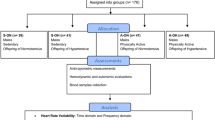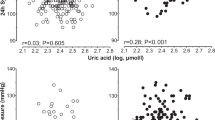Abstract
Family history of hypertension is associated with early autonomic dysfunction and increased oxidative stress. These alterations have been found to be reinforced by the overweight factor. Conversely, an active lifestyle is effective in improving the mechanisms regulating blood pressure control. Hence, we ought to investigate the effects of an active lifestyle on the hemodynamic, autonomic and oxidative stress parameters in individuals carrying both family history of hypertension and overweight risk factors. Fifty-six normotensive males were divided into four groups: eutrophic offspring of normotensive parents (EN, n = 12), eutrophic and inactive with hypertensive parents (EH, n = 14), overweight and inactive with hypertensive parents (OH, n = 13), and overweight and physically active with hypertensive parents (OAH, n = 17). Cardiovascular autonomic modulation was assessed by heart rate (HRV) and blood pressure (BPV) variability indexes. Oxidative stress included pro/antioxidant markers and nitrite concentration. Inactive offspring of hypertensive parents (EH and OH) showed higher LFSBP (vs EN), an indicator of sympathetic outflow to the vasculature and reduced anti-oxidant activity (vs EN), while higher pro-oxidant markers were found exclusively in OH (vs EN and EH). Conversely, the OAH group showed bradycardia, higher vagally-mediated HFabs index (vs OH and EN), lower sympathovagal balance (vs OH) and preserved LFSBP. Yet, the OAH showed preserved pro/antioxidant markers and nitrite levels. Our findings indicates that overweight offspring of hypertensive parents with an active lifestyle have improved hemodynamic, cardiac autonomic modulation and oxidative stress parameters compared to their inactive peers.
This is a preview of subscription content, access via your institution
Access options
Subscribe to this journal
Receive 12 digital issues and online access to articles
$119.00 per year
only $9.92 per issue
Buy this article
- Purchase on Springer Link
- Instant access to full article PDF
Prices may be subject to local taxes which are calculated during checkout


Similar content being viewed by others
Data availability
The datasets generated and/or analyzed during the current study are available from the corresponding author on reasonable request.
References
Allemann Y, Weidmann P. Cardiovascular, metabolic and hormonal dysregulations in normotensive offspring of essential hypertensive parents. J Hypertens. 1995;13:163–73.
Butler MG. Genetics of hypertension. Curr status J Med Liban. 2010;58:175–78.
Allemann Y, Hutter D, Aeschbacher BC, Fuhrer J, Delacretaz E, Weidmann P. Increased central body fat deposition precedes a significant rise in resting blood pressure in male offspring of essential hypertensive parents: a 5 year follow-up study. J Hypertens. 2001;19:2143–48.
Cassano PA, Segal MR, Vokonas PS, Weiss ST. Body fat distribution, blood pressure, and hypertension. A prospective cohort study of men in the normative aging study. Ann Epidemiol. 1990;1:33–48.
Viana A, Dias DDS, Nascimento MC, Dos Santos F, Lanza FC, Irigoyen MC, et al. Impact of overweight in mens with family history of hypertension: early heart rate variability and oxidative stress disarrangements. Oxid Med Cell Longev. 2020;2020:3049831.
Piccirillo G, Viola E, Nocco M, Durante M, Tarantini S, Marigliano V. Autonomic modulation of heart rate and blood pressure in normotensive offspring of hypertensive subjects. J Lab Clin Med. 2000;135:145–52.
Man AWC, Li H, Xia N. Impact of lifestyles (diet and exercise) on vascular health: oxidative stress and endothelial function. Oxid Med Cell Longev. 2020;2020:1496462.
Campbell R, Fisher JP, Sharman JE, McDonnell BJ, Frenneaux MP. Contribution of nitric oxide to the blood pressure and arterial responses to exercise in humans. J Hum Hypertens. 2011;25:262–70.
Santa-Rosa FA, Shimojo GL, Dias DS, Viana A, Lanza FC, Irigoyen MC, et al. Impact of an active lifestyle on heart rate variability and oxidative stress markers in offspring of hypertensives. Sci Rep. 2020;10:12439.
Brocklebank LA, Falconer CL, Page AS, Perry R, Cooper AR. Accelerometer-measured sedentary time and cardiometabolic biomarkers: A systematic review. Prev Med. 2015;76:92–102.
Ekelund U, Steene-Johannessen J, Brown WJ, Fagerland MW, Owen N, Powell KE, et al. Does physical activity attenuate, or even eliminate, the detrimental association of sitting time with mortality? A harmonised meta-analysis of data from more than 1 million men and women. Lancet (Lond, Engl). 2016;388:1302–10.
Jennings GL, Nelson L, Esler MD, Leonard P, Korner PI. Effects of changes in physical activity on blood pressure and sympathetic tone. J Hypertens Suppl. 1984;2:S139–41.
Machado EA, Farinatti P, Sicuro FL, Rodrigues F Jr, Bouskela E, Collett-Solberg PF. Daily physical activity, cardiorespiratory fitness, nutritional status, endothelial function, and autonomic modulation in school-age adolescents: a principal component analysis. Obes Res Clin Pr. 2021;15:205–11.
Godoy-Matos A, Oliveira J, Guedes E, Carraro L, Lopes A, Mancini M, et al. Diretrizes brasileiras de obesidade 2009/2010. 2009.
Craig CL, Marshall AL, Sjostrom M, Bauman AE, Booth ML, Ainsworth BE, et al. International physical activity questionnaire: 12-country reliability and validity. Med Sci Sports Exerc. 2003;35:1381–95.
Jackson AS, Pollock ML. Practical assessment of body composition. Phys Sportsmed. 1985;13:76–90.
Rodrigues B, Barboza CA, Moura EG, Ministro G, Ferreira-Melo SE, Castano JB, et al. Transcranial direct current stimulation modulates autonomic nervous system and reduces ambulatory blood pressure in hypertensives. Clin Exp Hypertens. 2021;43:320–27.
Force T. Heart rate variability: standards of measurement, physiological interpretation and clinical use. Task Force of the European Society of Cardiology and the North American Society of Pacing and Electrophysiology. Circulation. 1996;93:1043–65.
Ahmed MW, Kadish AH, Parker MA, Goldberger JJ. Effect of physiologic and pharmacologic adrenergic stimulation on heart rate variability. J Am Coll Cardiol. 1994;24:1082–90.
Diedrich A, Jordan J, Tank J, Shannon JR, Robertson R, Luft FC, et al. The sympathetic nervous system in hypertension: assessment by blood pressure variability and ganglionic blockade. J Hypertens. 2003;21:1677–86.
Lowry OH, Rosebrough NJ, Farr AL, Randall RJ. Protein measurement with the Folin phenol reagent. J Biol Chem. 1951;193:265–75.
Irigoyen MC, De Angelis K, Dos Santos F, Dartora DR, Rodrigues B, Consolim-Colombo FM. Hypertension, blood pressure variability, and target organ lesion. Curr Hypertens Rep. 2016;18:31.
Choi JW, Pai SH, Kim SK, Ito M, Park CS, Cha YN. Increases in nitric oxide concentrations correlate strongly with body fat in obese humans. Clin Chem. 2001;47:1106–09.
Terasaka N, Yu S, Yvan-Charvet L, Wang N, Mzhavia N, Langlois R, et al. ABCG1 and HDL protect against endothelial dysfunction in mice fed a high-cholesterol diet. J Clin Invest. 2008;118:3701–13.
Vincent HK, Taylor AG. Biomarkers and potential mechanisms of obesity-induced oxidant stress in humans. Int J Obes (Lond). 2006;30:400–18.
Li R, Lyn D, Lapu-Bula R, Oduwole A, Igho-Pemu P, Lankford B, et al. Relation of endothelial nitric oxide synthase gene to plasma nitric oxide level, endothelial function, and blood pressure in African Americans. Am J Hypertens. 2004;17:560–67.
Noronha BT, Li J-M, Wheatcroft SB, Shah AM, Kearney MTJD. Inducible nitric oxide synthase has divergent effects on vascular and metabolic function in obesity. Diabetes. 2005;54:1082–89.
Fitzgerald SM, Kemp-Harper BK, Parkington HC, Head GA, Evans RG. Endothelial dysfunction and arterial pressure regulation during early diabetes in mice: roles for nitric oxide and endothelium-derived hyperpolarizing factor. Am J Physiol Regul Integr Comp Physiol. 2007;293:R707–13.
Campese VM, Ye S, Zhong H, Yanamadala V, Ye Z, Chiu J. Reactive oxygen species stimulate central and peripheral sympathetic nervous system activity. Am J Physiol Heart Circ Physiol. 2004;287:H695–703.
Lénárd Z, Studinger P, Mersich B, Pavlik G, Kollai M. Cardiovagal autonomic function in sedentary and trained offspring of hypertensive parents. J Physiol. 2005;565:1031–38.
Pomeranz B, Macaulay RJ, Caudill MA, Kutz I, Adam D, Gordon D, et al. Assessment of autonomic function in humans by heart rate spectral analysis. Am J Physiol. 1985;248:H151–53.
Melanson EL. Resting heart rate variability in men varying in habitual physical activity. Med Sci Sports Exerc. 2000;32:1894–1901.
Wulsin LR, Horn PS, Perry JL, Massaro JM, D'Agostino RB. Autonomic imbalance as a predictor of metabolic risks, cardiovascular disease, diabetes, and mortality. J Clin Endocrinol Metab. 2015;100:2443–48.
Franzoni F, Ghiadoni L, Galetta F, Plantinga Y, Lubrano V, Huang Y, et al. Physical activity, plasma antioxidant capacity, and endothelium-dependent vasodilation in young and older men. Am J Hypertens. 2005;18:510–16.
Gohar EY, Pollock DM. Sex-specific contributions of endothelin to hypertension. Curr Hypertens Rep. 2018;20:58.
Unger T, Borghi C, Charchar F, Khan NA, Poulter NR, Prabhakaran D, et al. International society of hypertension global hypertension practice guidelines. Hypertension. 2020;75:1334–1357.0
Acknowledgements
We would like to acknowledge all of the volunteers for their willingness to participate in the study.
Funding
This study was supported by CNPq (457200/2014-6; 407398/2021-0; 406792/2022-4), CAPES (88881.062178/2014-01) and FAPESP (2019/27782-5). De Angelis, K. and Irigoyen, MC. are recipients of CNPq Fellowship (CNPq-BPQ).
Author information
Authors and Affiliations
Contributions
Authors have contributed to either (i) conception and design of the study (MCN, AV, SDC, MPR, KDA), (ii) acquisition, analysis, or interpretation of data (MCN, AV, DSD, FS, SDC, MCI, MPR, KDA), or (iii) drafting the work or revising it critically for important intellectual content (MCN, AV, DSD, FS, SDC, MCI, MPR, KDA). All authors have qualified for authorship and approved the final version of the manuscript. Finally, all authors agree being accountable with regards to ensuring accuracy and integrity for the work currently investigated.
Corresponding author
Ethics declarations
Competing interests
The authors declare no competing interests.
Ethical approval
Ethical approval was granted for this study from the UNINOVE Research Ethics Committee (No 1.672.599). All subjects provided written informed consent to participate. This study was conducted in accordance with the Declaration of Helsinki.
Additional information
Publisher’s note Springer Nature remains neutral with regard to jurisdictional claims in published maps and institutional affiliations.
Rights and permissions
Springer Nature or its licensor (e.g. a society or other partner) holds exclusive rights to this article under a publishing agreement with the author(s) or other rightsholder(s); author self-archiving of the accepted manuscript version of this article is solely governed by the terms of such publishing agreement and applicable law.
About this article
Cite this article
Nascimento, M.C., Viana, A., Dias, D.d.S. et al. Impact of an active lifestyle on cardiovascular autonomic modulation and oxidative stress in males with overweight and parental history of hypertension. J Hum Hypertens (2024). https://doi.org/10.1038/s41371-024-00895-5
Received:
Revised:
Accepted:
Published:
DOI: https://doi.org/10.1038/s41371-024-00895-5



